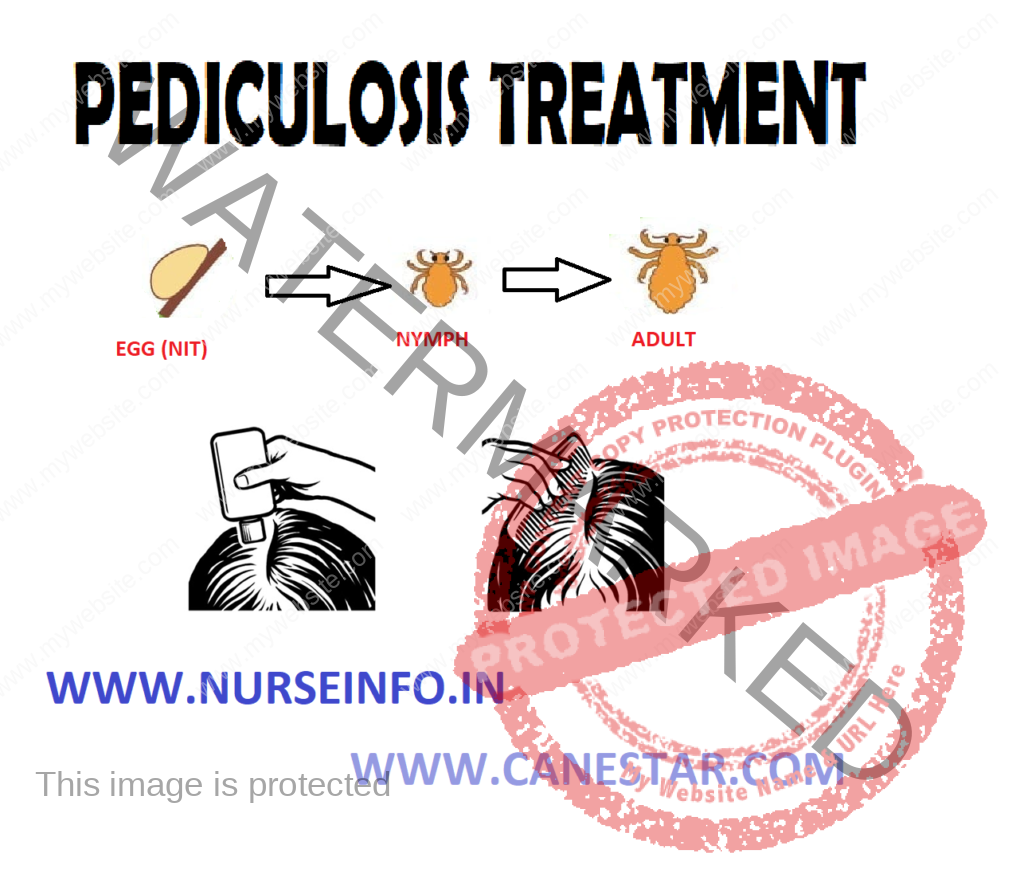PEDICULOSIS TREATMENT
NURSING PROCEDURES LIST CLICK HERE
Pediculosis is defined as the state of being infected with lice. Pediculi or lice is a small blood sucking parasite.
It is associated with poor personal hygiene. It can be acquired in overcrowded, unsanitary conditions and exposure to infected persons
Purpose
- To destroy pediculi and nits
- To prevent its transmission to other
- To promote comfort
- To promote sense of well-being
Dangers of Pediculosis
- Severe itching
- Scratching and as the result, abscess formation
- Presence of dandruff
- Restlessness and insomnia due to discomfort
- Anemia
- Presence of nodules at the back of head due to infected glands
Prevention of Pediculosis
- Proper personal hygiene should be maintained by every person
- Daily hair combing and frequently washing it
- If the patient complains of itching or scratches the head, examine hair and scalp thoroughly
Medications Used for Pediculosis Treatment
- DDT powder one part to nine part of talcum powder
- Kerosene mixed with equal parts of sweet oil destroys both lice and nits
- Carbolic acid 1:40
- Readily available lysil
- Preparations containing gamma, benzene hexachloride available in the market and can be used according to the instruction on the label
Types of Pediculi
- Pediculosis capitis: which infest the head
- Pediculosis corporis: which infest the body and is found with its flits in the clothing
- Pediculosis pubis: this infests the axillary and pubic hair, the eyebrows and sometimes the eyelashes
General instructions
- The parasiticides are applied thoroughly on the scalp (to the body if necessary) and is left for overnight
- On the next day a thorough bath is given and the linen is changed
- The linen should be thoroughly disinfected to remove the lice from the cloths
- Since, the parasiticides are not effective against the nits (eggs) the procedure is repeated after a week
Preliminary Assessment
Check
- Doctors order for specific precautions
- General condition of the patient
- Condition of the scalp and the hair
- Assess mental state to follow the instructions
- Articles available in the patients unit
Equipment
A tray containing
- Mackintosh – 1
- Bath towels – 2
- Wash cloth – 1
- A cap, a triangular bandage or a towel folded diagonally
- Safety pins
- Kidney tray with disinfectant, e.g. carbolic acid 1:40
- Paper bag
- Hair comb
- Cotton swabs or gauze piece in a container
- Vaseline
- Gown mask and cap
- Bucket with antiseptic solution, e.g. carbolic acid 5%
Preparation of the Patient and the Unit
- Explain the sequence of procedure
- Provide privacy by means of screens
- Arrange the articles conveniently on the bedside
- Place the patient flat if the condition permits
- Bring the patients head and shoulder to the edge of the bed
- Protect the pillow and bed with a mackintosh and a towel
- Protect the patient’s eyes with a clean damp wash cloth
- Pull off the fan to prevent the parasiticide spilling over the face during its application
- Loosen the hair and comb out the tangles
Procedure
- Wash hands thoroughly
- Put on gown, mask and cap
- Part the hair into small sections and apply the parasiticide on the hair and scalp, rubbing gently
- In long hairs, the medicine is to be applied along the whole length of the hair
- Roll up the long hair to the top of the head and cover the head with cap or triangular bandage or by a towel folded diagonally secure it with pins
Note: the treatment is done in the evening and left over night
After Care
- Remove the Mackintosh and towels from under the patients head
- Tidy up the bed; place the patient in a comfortable position
- Remove the gown, mask and cap and put them into the antiseptic lotion
- Replace the articles in their proper place after clean and disinfect
- Record and report the procedure in the nurses record sheet
- The hair is washed in the following morning
- Comb the hair with a fine toothed comb
- Repeat the procedure after one week because the nits are not affected by the parasiticides
- Disinfect all the articles that have come in contact with the hair by immersing them in carbolic acid 1:20 for one hour before washing



Its use full one…..👍👍